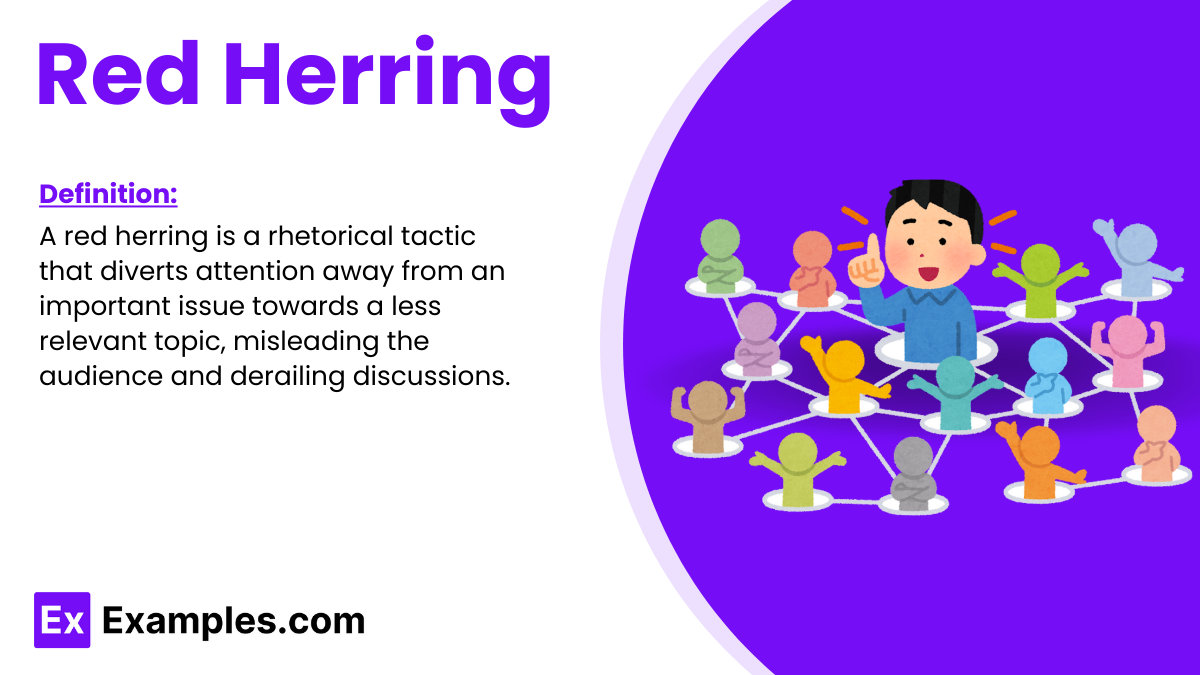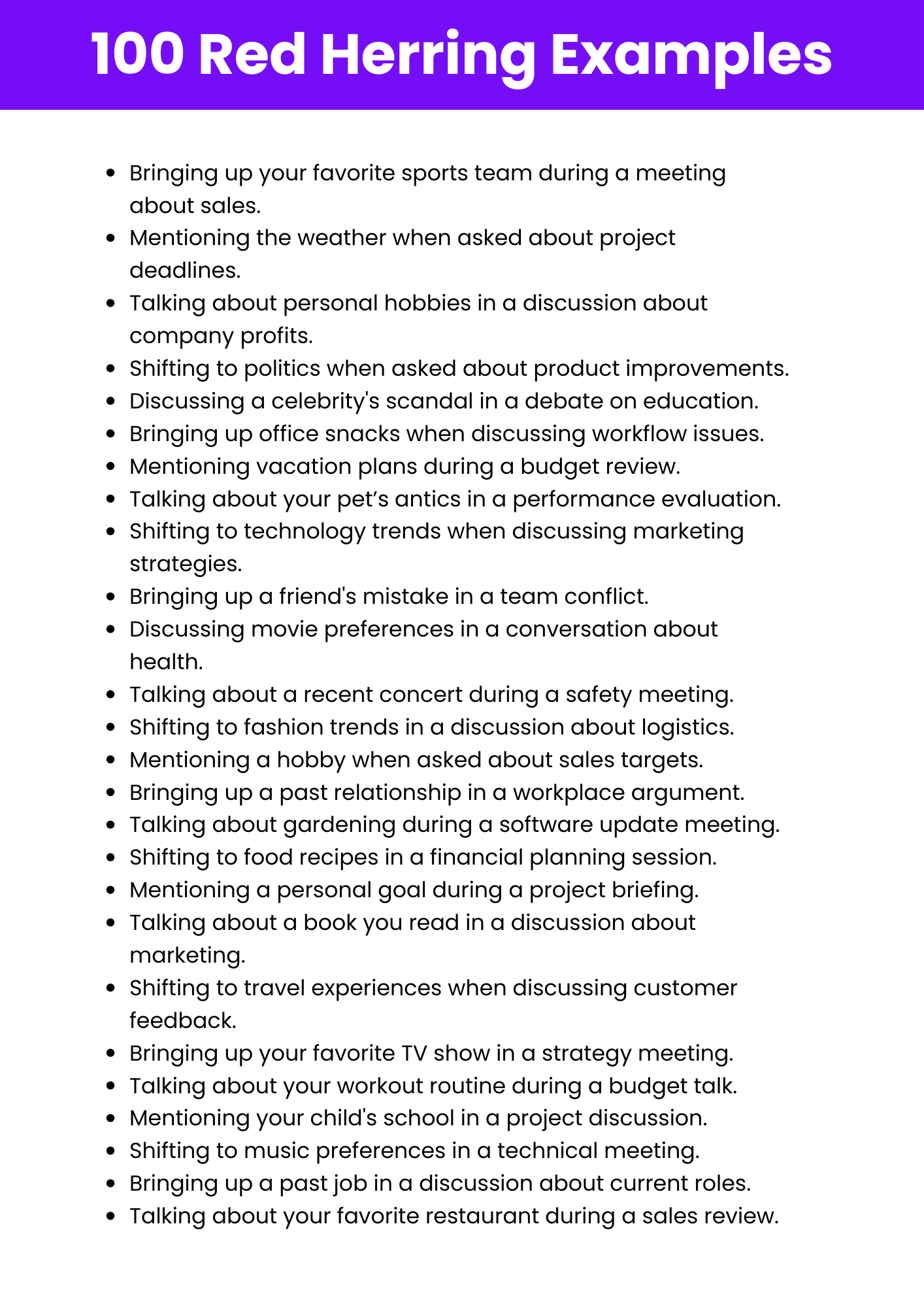Red Herring
What is Red Herring? – Definition
A Red Herring is a way of misleading or distracting from the main issue by introducing an irrelevant topic. It’s not meant to be taken seriously but helps to divert attention or create a twist in narratives.


Download Red Herring Examples
Enhance your understanding with our comprehensive PDF guide.
Download PDFExamples of Red Herrings
- The detective found an old photograph that had no connection to the case.
- A character suddenly starts talking about the weather in the middle of the investigation.
- Introducing a subplot about a neighbor’s gardening hobby that distracts from the main mystery.
- A mysterious package arrives with no relevance to the ongoing investigation.
- A side character reveals a secret that leads nowhere in the story.
- An unrelated rumor circulates among the townspeople during the investigation.
- A character’s sudden change in behavior that doesn’t affect the plot.
- A false lead about a suspect who is innocent.
- A misleading clue that points away from the real culprit.
- A distraction in the form of a secondary plot about a lost pet.
- An irrelevant witness provides a statement that doesn’t contribute to solving the mystery.
- A subplot involving a friend’s vacation distracts from the main storyline.
- A mysterious letter arrives that leads to no significant developments.
- A secondary investigation into a minor incident that doesn’t affect the main plot.
- A red herring involving a local legend that misleads the characters.
- An unrelated event occurs that diverts the investigation.
- A character introduces an unrelated theory that confuses the main investigation.
- A misleading clue that points to an innocent character.
- A subplot about a character’s personal issues that has no bearing on the main story.
- An irrelevant conversation that diverts attention from the real problem.
- A misleading clue that suggests a different motive for the crime.
- An unrelated subplot involving a side character’s adventure.
- A false lead that points to an innocent person.
- An irrelevant event that distracts from the main plot.
- A misleading clue that leads characters astray.
- An unrelated discovery that confuses the investigation.
- A side plot about a character’s hobby that doesn’t impact the main story.
- An irrelevant subplot that distracts from the main narrative.
- A false clue that leads characters away from the truth.
- A misleading plot twist that confuses the audience.
Types of Red Herrings
Emotional Red Herrings
Emotional elements divert from logical reasoning.
- Tragic backstory evokes sympathy.
- Romantic subplot sidetracks hero.
- Family drama overshadows mystery.
- Personal guilt distracts focus.
- Fear clouds judgment.
Logical Red Herrings
Flawed reasoning misleads from the solution.
- Irrelevant conclusion presented.
- False choice between two options.
- Misleading analogy used.
- Circular logic goes nowhere.
- Oversimplified argument misleads.
How to Identify/Find Red Herring?
To identify Red Herrings, look for elements that divert attention from the main issue without adding meaningful information. Red Herrings often introduce unrelated topics or misleading clues that create confusion or suspense.
- Look for elements that seem out of place or irrelevant to the main plot.
- Identify distractions that lead the audience away from the central narrative.
- Check if the introduced element serves to confuse or add complexity without relevance.
- Notice if the element adds suspense or mystery without advancing the plot.
- Look for clues that are deliberately misleading or provide false leads.
How to Use Red Herring?
Use Red Herrings to add suspense and complexity to your storytelling by introducing misleading elements that keep the audience guessing. Ensure that Red Herrings are plausible enough to be believable but ultimately irrelevant to the main plot.
- Introduce plausible but ultimately irrelevant clues.
- Use subtle hints to make Red Herrings believable.
- Integrate Red Herrings seamlessly into the narrative without disrupting the flow.
- Ensure Red Herrings enhance the mystery or suspense without overshadowing the main plot.
- Avoid overusing Red Herrings to maintain their effectiveness and prevent audience frustration.
Other Red Herring Examples
Explore Other Literary Devices
Elevate Your AP English Preparation
Unlock your potential with our comprehensive AP English exam preparation tools designed to help you excel.
- Extensive Question Bank: Access 900+ exam-like questions for both AP English Language and Literature.
- Expertly Crafted: Questions mirror the structure and difficulty of actual AP exams, ensuring relevant practice.
- Detailed Explanations: Understand your mistakes with clear, concise breakdowns of correct and incorrect answers.
- Personalized Learning: Tailor your study sessions with topic-specific tests and adaptive learning tools.
- Comprehensive Coverage: Master all aspects of the AP English curriculum with extensive guides and resources.
Frequently Asked Questions
-
What is a Red Herring?
A Red Herring is a literary device used to mislead or distract the audience from the main issue by introducing an irrelevant element or false clue. -
How does a Red Herring differ from a plot twist?
Unlike plot twists, which reveal unexpected developments relevant to the main plot, Red Herrings intentionally divert attention away without adding meaningful progression. -
Why are Red Herrings important in storytelling?
Red Herrings add complexity and suspense to narratives by keeping the audience guessing and preventing predictability, enhancing engagement and intrigue. -
Can Red Herrings be overused?
Yes, overusing Red Herrings can lead to confusion and frustration among the audience, diminishing their effectiveness and the overall quality of the story. -
How can I effectively create my own Red Herrings?
To create effective Red Herrings, introduce plausible but ultimately irrelevant elements that align with the story’s context, ensuring they are subtle enough to mislead without causing disengagement.

